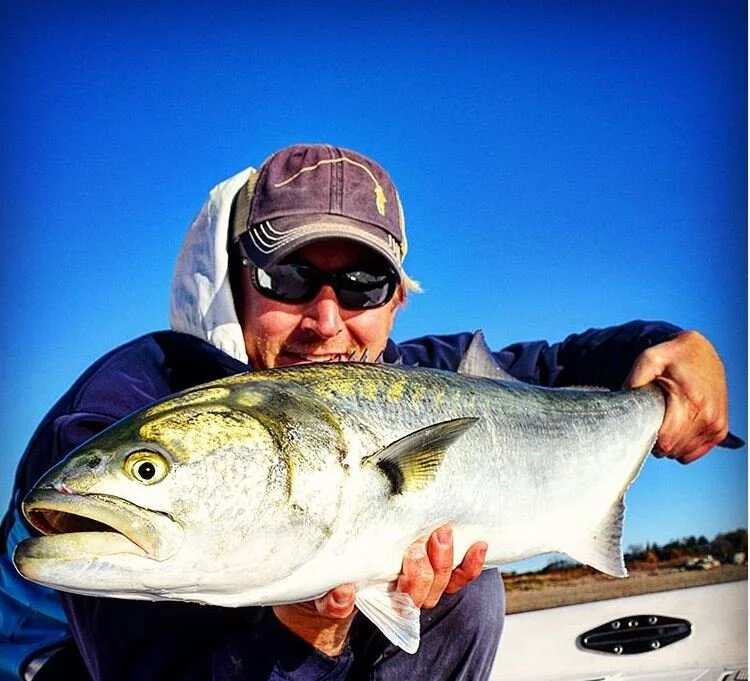ASGA 2020 Recap / Update - bluefish status
February 4, 2020
The American Saltwater Guides Association held its Annual Board Meeting at The Fly Fishing Show in Edison, NJ on January 25.
At the end of the meeting, the ASGA held a public session, during which policy updates were presented, outlining the current status of management around fisheries and species that the organization (and that we at Tightlined) are focused on, including some general outlook as to what we might run into in the coming year.
Here’s the update on bluefish.
Where We Are Now
We’ll start this one the same way we did with striped bass - bluefish are overfished. That said, unlike striped bass overfishing is not occurring (more on that in a minute).
The solid line represents mortality by each year, the dotted line represents the target (sustainable) harvest, representing that we have overfished every year since the data started in 1985 except 2018, the year the new regulations are based off.
Another big difference between stripers and bluefish, is the reaction of the regulatory body. Bluefish are not managed by the ASFMC, they are managed federally, under Magnuson-Stevens. In contrast to the ASFMC, which took years to change the regulations in an attempt to allow bass to recover, new Bluefish regulations - from 15 fish per person per day to 3 fish per person per day (5 for the for-hire fleet) - were put in place in a matter of months. Not only that, there are accountability measures associated with any federal regulation, so if (and probably when), more fish are harvested than projected, payback is required, meaning even stricter regulations (or a moratorium) would be put in place the next year.
How We Got Here
There’s more to this than a simple, we caught too many fish. While that’s true, the issue really comes back to the fact that new MRIP data (the Marine Recreational Information Program) showed that there was substantially more effort (trips taken targeting bluefish) historically than expected. As a result, we have overfished bluefish (taken too many fish out of the ocean each year) every year since 1985, with the exception of 2018, and the stock has been overfished (not enough fish left in the ocean as a whole) since 2014.
The solid line represents the biomass. The upper dotted line represents the biomass target (where we need to rebuild to), and the lower dotted line represents the biomass threshold, which we fell below in 2014. The bars represent recruitment for each year (below average recently)
Together, these facts mean that, since there are still any bluefish left despite being overfished consistently for years, there were likely a lot more fish out there than we originally thought there were, which changes the equation of what makes a healthy stock and what is sustainable in terms of harvest.
What’s Next
First, the new regulations are in effect, which represent a drastic reduction in daily limit for both recreational and for-hire anglers. That said, it will likely not be enough, and the reason for that comes back to the fact that overfishing did not occur in 2018, the year these new regulations are based off. Like with striped bass, when new regulations are put in place, they are intended to result in a target reduction in harvest from previous harvest levels to get the total removals down to an acceptable number. For bluefish, the target is a 28.56% reduction in harvest. However, that reduction is based off 2018 levels, which were the lowest harvest we have realized since 1981. Given that 2018 was such a down year (there were more fish harvested in the first 9 months of 2019 than there were in all of 2018), it is very likely that we will harvest more fish in 2020 than we did in 2018, meaning that 28.56% harvest reduction target will not be met. Further, that over-harvest will likely be significant.
This is where the fun will really begin, because, again, bluefish are managed federally, under Magnuson- Stevens, which REQUIRES payback if overfishing occurs. Since there will likely still be significant overages in 2020 despite the daily limits being reduced drastically, there will need to be payback in 2021. As a result, there’s a real chance that we’ll be looking at a full closure of the bluefish fishery in 2021 (possibly even including a ban on targeting the species to reduce release-mortality).
With that said, again, the new MRIP data kind of blew the top off the way these fish are viewed and what a healthy stock is. The new data also exposed the fact that the biomass target represents a level of abundance that we really have never reached. As a result of that, it’s legitimate to question what impact that many bluefish might have on the ecosystem as a whole. Would they eat everything? Would they push striped bass and other species out?
This data is all still pretty fresh, and the Council needs some time to review the information and determine what the best path forward is, because the biological reference points that have been historically used have been thrown off by the new data. All in all, however, swift action has been taken, with further action likely to come to protect and rebuild this stock back to the target levels.
We’ll cover menhaden tomorrow, and if you missed yesterday’s writeup on striped bass, take a read.



